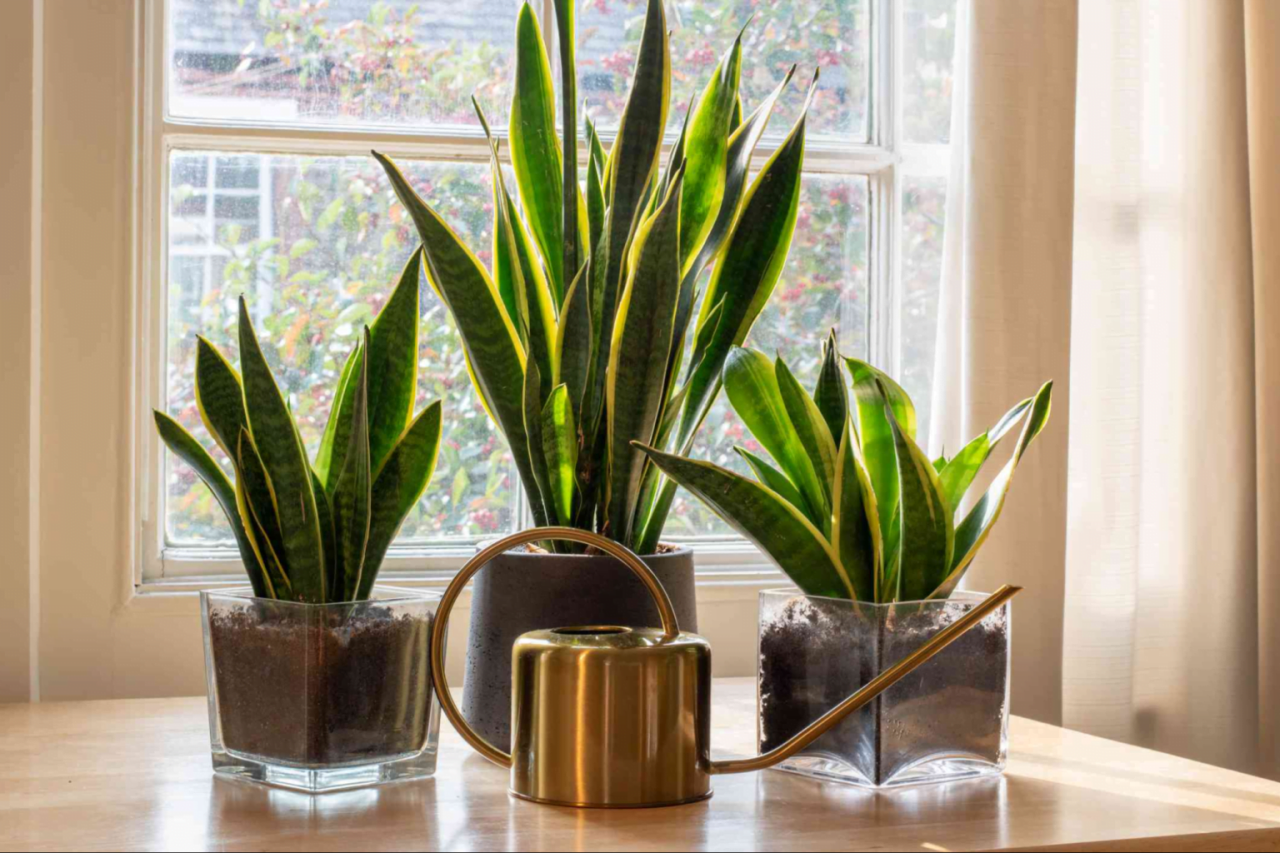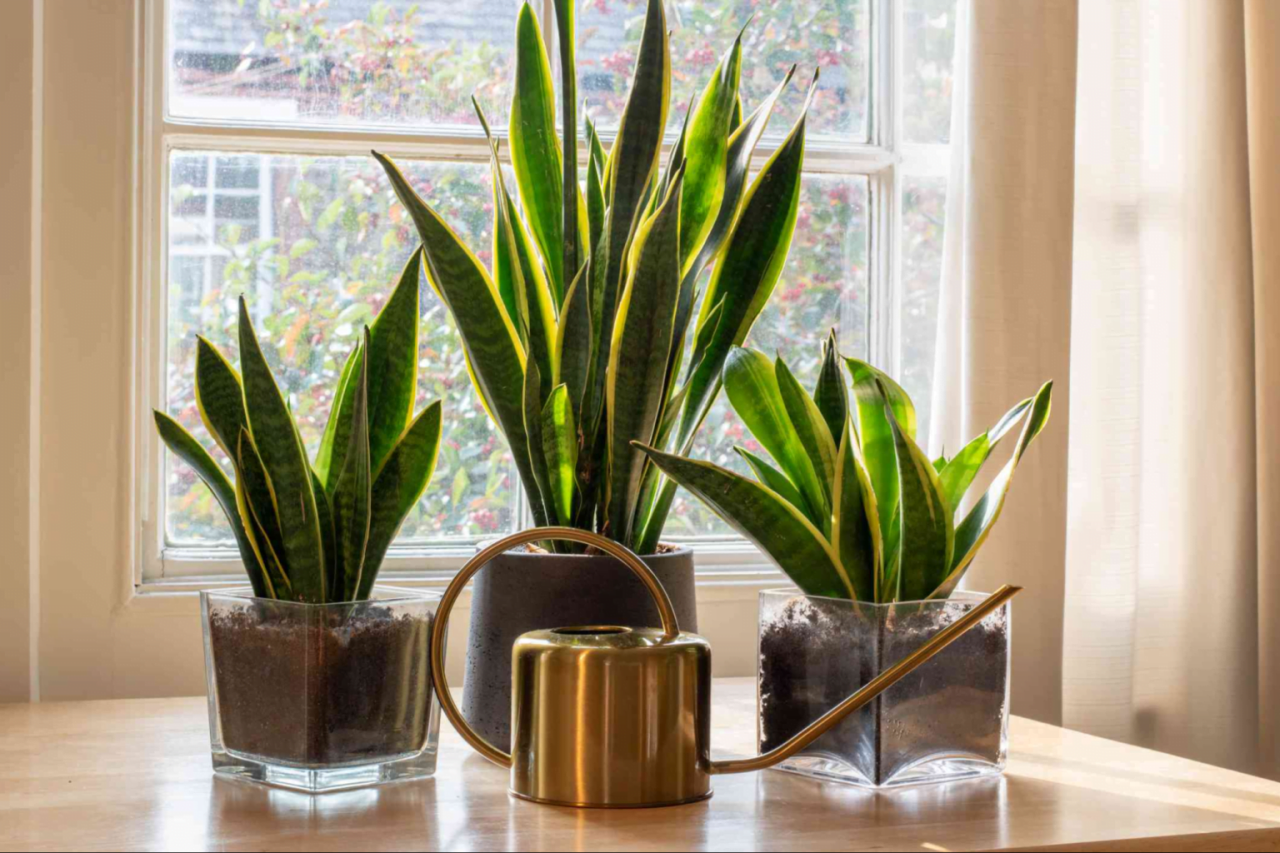How to Properly Water Your Snake Plant: Known for their resilience, snake plants are popular houseplants, but even these tough greens need the right watering routine to thrive. Understanding their water storage capacity and tolerance for drought is crucial, as overwatering can lead to root rot and other issues.
This guide delves into the intricacies of snake plant hydration, exploring the optimal watering frequency, techniques, and seasonal adjustments for a healthy and vibrant plant.
From the “soak and dry” method to recognizing signs of under- and overwatering, this comprehensive guide provides a step-by-step approach to ensuring your snake plant receives the perfect amount of moisture. Discover how to adjust your watering practices based on factors like pot size, soil type, and environmental conditions, ensuring your plant flourishes year-round.
Understanding Snake Plant Watering Needs

The snake plant, known for its resilience and adaptability, is a low-maintenance houseplant that can tolerate periods of drought. This is due to its unique ability to store water in its thick, succulent leaves. However, understanding the snake plant’s watering needs is crucial for its healthy growth and development.
Factors Influencing Watering Frequency
The frequency of watering your snake plant depends on several factors, including the pot size, soil type, and environmental conditions.
- Pot Size:Smaller pots have less soil volume, leading to quicker drying. Therefore, snake plants in smaller pots require more frequent watering compared to those in larger pots.
- Soil Type:Well-draining soil allows for faster water absorption and evaporation, leading to more frequent watering. Conversely, dense, clay-based soils retain moisture for longer periods, requiring less frequent watering.
- Environmental Conditions:Factors like temperature, humidity, and light intensity can influence the rate of soil drying. Warmer temperatures and low humidity lead to faster evaporation, requiring more frequent watering. Similarly, brighter light conditions can increase the plant’s water needs.
General Guideline for Watering Frequency, How to Properly Water Your Snake Plant
A general rule of thumb is to allow the soil to dry out completely between waterings. This can be determined by checking the moisture level with your finger or using a moisture meter. When the top inch of soil feels dry, it is time to water the snake plant thoroughly.
Proper Watering Techniques
Now that you understand the watering needs of your snake plant, let’s delve into the proper techniques to ensure its health and vitality.
The “Soak and Dry” Method
The “soak and dry” method is the most effective way to water your snake plant. This involves thoroughly saturating the soil, allowing it to drain completely, and then letting it dry out before watering again.
Thorough saturation is crucial because it ensures that water reaches the roots, providing them with the necessary moisture. To achieve this, water the plant until water flows out of the drainage holes at the bottom of the pot.
Once the soil is saturated, allow it to dry out completely before watering again. This means that the top inch or two of the soil should be dry to the touch.
Using a Watering Can
A watering can with a long spout is an ideal tool for watering snake plants. The long spout allows you to reach the base of the plant, ensuring that the water penetrates the soil effectively.
When watering, aim the spout at the base of the plant, avoiding the leaves. This helps prevent water from pooling on the leaves, which can lead to fungal diseases.
Avoiding Overwatering
Overwatering is one of the most common mistakes made by snake plant owners. Overwatering can lead to root rot, a condition that can be fatal to the plant.
- Check the soil moisture: Before watering, check the soil moisture with your finger or a moisture meter. If the top inch or two of the soil is still moist, wait a few more days before watering again.
- Avoid frequent, shallow watering: Frequent, shallow watering can lead to overwatering. Instead, water deeply and infrequently, allowing the soil to dry out completely between waterings.
- Choose a well-draining pot: A pot with drainage holes is essential for allowing excess water to drain away.
Signs of Underwatering and Overwatering
While understanding the proper watering needs of your snake plant is crucial, it’s equally important to recognize the signs of both underwatering and overwatering. These visual cues can help you determine if your plant needs more or less water, preventing potential problems.
Underwatering Symptoms
An underwatered snake plant will exhibit distinct visual cues, indicating its need for hydration. These symptoms are a direct result of the plant’s struggle to maintain its moisture balance.
- Wilting Leaves:Underwatered snake plants often display wilting leaves, which lose their rigidity and droop downwards. This is a direct consequence of the plant’s inability to maintain its turgor pressure, leading to a limp appearance.
- Dry Soil:The most obvious sign of underwatering is dry soil. The top layer of soil should feel dry to the touch, and the soil might even pull away from the sides of the pot.
- Leaf Color Changes:Underwatering can cause the leaves to turn a paler shade of green or even yellow. This is because the plant is not receiving enough water to produce chlorophyll, the pigment responsible for its green color.
Overwatering Symptoms
Overwatering, on the other hand, can be equally detrimental to your snake plant. Excessive watering can lead to root rot and other issues that can ultimately kill the plant.
- Yellowing Leaves:Overwatering can cause leaves to turn yellow, starting at the base and progressing upwards. This is a sign that the roots are not getting enough oxygen due to waterlogged soil.
- Soft Stems:Overwatering can make the stems of the snake plant soft and mushy. This is a sign that the roots are rotting and the plant is no longer able to support itself.
- Root Rot:The most serious consequence of overwatering is root rot. This occurs when the roots are constantly submerged in water and begin to decay. Root rot can be difficult to detect early on, but it can eventually lead to the death of the plant.
Visual Comparison of Underwatering and Overwatering Symptoms
The following table provides a visual comparison of the symptoms of underwatering and overwatering, helping you identify the issue and take appropriate action.
Symptom |
Description |
Image |
Cause |
|---|---|---|---|
Wilting Leaves |
Leaves lose their rigidity and droop downwards. |
[Image of wilting snake plant leaves] |
Lack of water, leading to reduced turgor pressure. |
Dry Soil |
The top layer of soil feels dry to the touch. |
[Image of dry soil in a snake plant pot] |
Insufficient watering. |
Yellowing Leaves (Underwatering) |
Leaves turn a paler shade of green or yellow due to chlorophyll deficiency. |
[Image of yellowing snake plant leaves due to underwatering] |
Lack of water, preventing chlorophyll production. |
Yellowing Leaves (Overwatering) |
Leaves turn yellow, starting at the base, due to waterlogged soil. |
[Image of yellowing snake plant leaves due to overwatering] |
Excess water, leading to root rot and oxygen deprivation. |
Soft Stems |
Stems become soft and mushy due to root rot. |
[Image of soft, mushy stems on a snake plant] |
Overwatering, resulting in root decay and weakened structure. |
Root Rot |
Roots decay due to constant submersion in water. |
[Image of root rot on a snake plant] |
Excessive watering, leading to anaerobic conditions and root damage. |
Seasonal Watering Adjustments
Snake plants are resilient, but even they require adjustments to their watering routine based on seasonal changes. The goal is to provide just enough water to keep the soil slightly moist without letting it become soggy.
Watering Frequency Adjustments
The frequency of watering should be adjusted based on the seasons. During the summer, snake plants require more frequent watering due to increased temperatures and evaporation. However, in winter, their growth slows down, and they need less water.
- Summer:Water more frequently, typically every 1-2 weeks, depending on the temperature and humidity levels. Check the soil moisture by inserting your finger about 2 inches deep. If the soil feels dry, it’s time to water.
- Winter:Reduce watering to once every 4-6 weeks, or even less if the air is dry and the plant is dormant.
The soil should be allowed to dry out completely between waterings.
Humidity and Watering
Humidity levels can significantly impact watering needs. In dry climates, snake plants may need to be watered more frequently than in humid environments. The reason is that dry air increases evaporation from the soil, making it dry out faster.
- Dry Climates:Increase watering frequency to compensate for increased evaporation. You may need to water every 1-2 weeks, even in winter.
- Humid Climates:Reduce watering frequency, as the soil will retain moisture for longer periods. You may only need to water every 4-6 weeks in winter.
Just like choosing the right pot material for your bonsai tree ( Bonsai Pot Materials: Which One is Best for Your Tree? ), selecting the appropriate container for your snake plant is crucial for its well-being. A well-draining pot is essential for preventing overwatering, which can lead to root rot and ultimately, a sickly plant.
By choosing a pot that allows excess water to escape, you’re ensuring your snake plant thrives and displays its vibrant foliage.
Environmental Considerations
Several environmental factors can influence the frequency of watering. Pay attention to the following:
- Light Levels:Snake plants thrive in bright, indirect light. If they are exposed to direct sunlight, they may need more frequent watering as the soil dries out faster.
- Pot Size:Larger pots retain moisture for longer periods, while smaller pots dry out faster.
Adjust watering frequency accordingly.
- Soil Type:Well-draining soil is crucial for snake plants. If the soil is too dense, it can retain water and lead to root rot. Use a potting mix specifically designed for succulents or cacti.
Additional Watering Considerations: How To Properly Water Your Snake Plant
Beyond the basic watering techniques, several additional factors play a crucial role in maintaining the health of your snake plant. These considerations ensure that your plant receives the right amount of moisture and prevents potential issues.
Well-Draining Soil
Well-draining soil is essential for snake plants, as it allows excess water to pass through, preventing waterlogging and root rot. Waterlogging occurs when the soil remains too wet for extended periods, leading to a lack of oxygen for the roots, which can eventually cause them to decay.
To create well-draining soil, you can use a potting mix specifically designed for succulents or cacti. These mixes typically contain ingredients like perlite, pumice, or coco coir, which enhance drainage and aeration. Alternatively, you can amend regular potting soil with these ingredients to improve its drainage capabilities.
Pots with Drainage Holes
Pots with drainage holes are crucial for snake plants. These holes allow excess water to escape, preventing the soil from becoming waterlogged. Without drainage holes, water will accumulate at the bottom of the pot, creating an environment that promotes root rot.
Choose pots with multiple drainage holes to ensure efficient water removal.
Just like a snake plant thrives in well-draining soil, a bonsai tree needs a pot that allows for proper drainage and airflow. Choosing the right pot for your bonsai is crucial for its health and longevity, just like selecting the correct watering technique for your snake plant.
When deciding on a pot for your outdoor bonsai, consider the size, material, and drainage holes. How to Select the Perfect Bonsai Pot for Outdoor Trees offers a comprehensive guide to help you make the best choice for your tree.
Similar to bonsai, snake plants benefit from being allowed to dry out between waterings, preventing root rot and promoting healthy growth.
Fertilizing Snake Plants
Fertilizing your snake plant during the growing season can help promote healthy growth and vibrant foliage. The best time to fertilize is during the spring and summer months when the plant is actively growing. Use a balanced fertilizer specifically formulated for succulents or cacti, following the instructions on the product label.
Excessive fertilization can harm the plant, so it’s essential to use a diluted solution and apply it sparingly. Avoid fertilizing during the winter months when the plant is dormant.
Final Review

Mastering the art of watering your snake plant is essential for its long-term health and beauty. By understanding its unique needs and following the tips Artikeld in this guide, you can provide the optimal moisture balance for your plant to thrive.
From the “soak and dry” method to recognizing signs of overwatering, this guide equips you with the knowledge and techniques to keep your snake plant happy and flourishing for years to come.
FAQ Resource
How often should I water my snake plant?
The frequency depends on factors like pot size, soil type, and environmental conditions. Generally, allow the soil to dry out completely between waterings, which can be anywhere from every 2-4 weeks.
What are the signs of overwatering a snake plant?
Yellowing leaves, soft stems, and root rot are common signs of overwatering. The soil may also remain wet for extended periods.
Can I use tap water to water my snake plant?
Yes, tap water is generally fine, but allowing it to sit for 24 hours to allow chlorine to dissipate is recommended.
Do snake plants need fertilizer?
While not essential, fertilizing during the growing season (spring and summer) with a balanced fertilizer can promote healthy growth.
